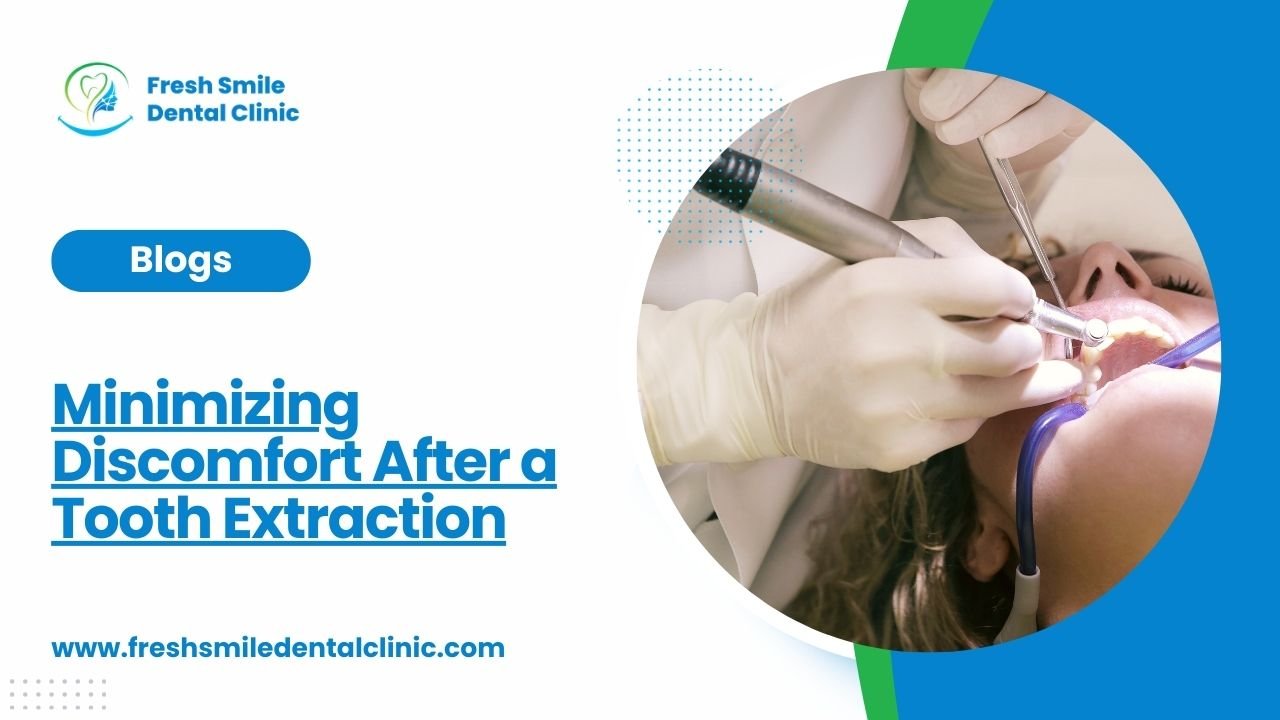Tips and Techniques in Minimizing Discomfort After a Tooth Extraction
A tooth extraction, whether simple or surgical, is a dental procedure that may lead to post-operative discomfort and pain. While some degree of discomfort is common, there are various strategies and techniques to help minimize it and ensure a smoother recovery. In this comprehensive guide, we’ll discuss these tips and techniques to help patients manage pain and discomfort after a tooth extraction. We’ll also provide recommendations for medications and proper care instructions, all explained in simple English for your convenience.
What Causes Post-Extraction Discomfort?
Post-extraction discomfort, commonly experienced after dental tooth removal, stems from a variety of factors. The procedure itself involves some degree of surgical trauma as the tooth is removed from its socket. Consequently, the surrounding tissues, including the gums and bone, may be affected, leading to pain and discomfort. Inflammation, a natural response to this trauma, can intensify the discomfort. Inflammatory chemicals trigger swelling, redness, and pain in the area, all essential elements of the healing process, albeit uncomfortable. Additionally, the sensitivity of oral nerves can contribute to post-extraction discomfort, as they may become irritated during and after the extraction process.
Bleeding is another factor, as some post-extraction bleeding is normal, and excessive bleeding can lead to discomfort. The formation and preservation of a blood clot at the extraction site are crucial for proper healing, so any disruption to this clot can result in pain and potential complications. In rare instances, infections may develop after extraction, causing notable discomfort. Adequate post-extraction care, including maintaining cleanliness in the area, is essential to prevent infection. Dry socket, a painful condition, can occur if the blood clot is prematurely dislodged or dissolves. It exposes the underlying bone and nerves, intensifying discomfort. Furthermore, underlying dental issues such as infection or decay may persist or worsen post-extraction, causing ongoing discomfort. As the extraction site heals, bone resorption, which may cause changes in bite and surrounding teeth, can result in discomfort. Occasionally, small bone fragments or sharp edges left in the socket may lead to foreign body sensations and discomfort. Individual pain tolerance varies, meaning what one person might perceive as mild discomfort could be more intense for another. It’s essential to follow post-extraction care instructions from your dentist and, if necessary, contact them in cases of severe or prolonged pain for further evaluation and guidance.
Importance of Pain Management
Pain management plays a pivotal role in the well-being of individuals across the spectrum of healthcare. It encompasses a wide array of techniques and strategies designed to alleviate and control pain, regardless of its origin or duration. The importance of effective pain management cannot be overstated, as it has profound implications for the overall health and quality of life of individuals.
Foremost, pain management is instrumental in enhancing the quality of life. The experience of pain, whether acute or chronic, can be all-encompassing, affecting one’s physical, emotional, and mental well-being. Effective pain management empowers individuals to regain control over their lives by alleviating discomfort. It enables them to participate in daily activities, enjoy hobbies, and engage in social interactions without the constant hindrance of pain. This, in turn, leads to a more fulfilling and vibrant life.
In the realm of physical health, pain management is closely intertwined with the restoration and maintenance of physical function. After surgeries or injuries, for example, pain can be debilitating. It hampers mobility, making it difficult to engage in necessary rehabilitation and physical therapy. By effectively managing pain, individuals are better equipped to participate in these crucial activities, facilitating the recovery process and the regaining of physical function.
Emotional well-being is another sphere where pain management holds immense significance. Chronic pain, in particular, has the potential to erode mental health. The constant presence of discomfort, whether from a medical condition or injury, can lead to anxiety, depression, and other emotional challenges. Effective pain management offers relief from this emotional burden. It can alleviate the emotional distress associated with pain, contributing to a more positive outlook on life and improving overall mental well-being.
Furthermore, pain management plays a pivotal role in the realm of sleep quality. Chronic pain often disrupts sleep patterns, leading to fatigue and additional health issues. This ripple effect can have serious consequences on physical and mental health. Effective pain management, by mitigating discomfort, enables better sleep. Quality sleep, in turn, has far-reaching benefits, such as improved cognitive function, better mood, and enhanced overall health.
In a medical context, pain management is indispensable for ensuring faster recovery after surgeries and medical procedures. By keeping pain under control, healthcare professionals can facilitate rehabilitation and therapy, allowing patients to regain mobility and function sooner. This can lead to shorter hospital stays, reduced healthcare costs, and an improved patient experience.
In cases of chronic pain conditions, effective pain management becomes a long-term strategy for maintaining a satisfactory quality of life. It allows individuals to lead more functional lives despite the presence of ongoing discomfort. This is particularly significant as chronic pain can be related to conditions such as arthritis, neuropathy, or fibromyalgia. Through a combination of medication, physical therapy, and psychological support, chronic pain can be managed effectively, helping individuals live more fulfilling lives.
Moreover, pain management is essential in fostering patient trust and satisfaction in the healthcare system. Patients who receive adequate pain management perceive a higher quality of care and are more likely to trust their healthcare providers. Effective pain control not only contributes to improved patient outcomes but also enhances the overall patient experience.
In the context of end-of-life care, palliative pain management is indispensable for providing comfort and dignity to patients facing terminal illnesses. By effectively managing pain, healthcare professionals can significantly improve the quality of life for individuals in their final stages, ensuring that they are as pain-free and comfortable as possible.
Ultimately, the importance of pain management transcends medical and physical realms. It touches upon the very essence of humanity, influencing our ability to experience life to its fullest. By relieving pain, we provide individuals with the opportunity to live with greater joy, mobility, and emotional well-being. Effective pain management is, in essence, a testament to our commitment to enhancing the human experience, one relieved ache at a time.
Tips and Techniques for Pain Minimization
Follow Dentist’s Instructions
Always adhere to your dentist’s post-operative instructions. They may provide specific guidance based on your extraction type and overall health.
Medication Recommendations
Your dentist may prescribe or recommend pain relievers. Common options include over-the-counter pain medications like ibuprofen (Advil) or acetaminophen (Tylenol). Follow the recommended dosage instructions.
Cold Compresses
Applying cold compresses to the outside of your cheek for 20 minutes at a time can help reduce swelling and numb the area. Use a cloth or towel as a barrier to prevent direct contact with the skin.
Soft Diet
Stick to a soft diet for the first few days after the extraction. Opt for foods like yogurt, mashed potatoes, soup, and smoothies. Avoid hot, spicy, or hard foods that may irritate the extraction site.
Hydration
Stay hydrated by drinking plenty of fluids. However, avoid using straws during the initial healing period, as the sucking motion can disrupt the blood clot forming in the extraction site.
Oral Hygiene
Maintain proper oral hygiene but be gentle around the extraction site. Avoid brushing the area for the first 24 hours. Afterward, use a soft-bristle toothbrush and rinse your mouth with warm saltwater as directed by your dentist.
Rest
Give your body the rest it needs to heal. Avoid strenuous activities and get plenty of sleep during the initial recovery period.
Managing Pain Sensibly
Over-the-Counter Medications
Over-the-counter pain relievers like ibuprofen or acetaminophen can be effective for managing post-extraction discomfort. Always follow the recommended dosage on the label or your dentist’s instructions.
Prescription Medications
In some cases, your dentist may prescribe stronger pain medications if over-the-counter options aren’t sufficient. Follow the prescribed dosage carefully, and be aware of any potential side effects.
Non-Pharmacological Approaches
Non-pharmacological pain management techniques, such as relaxation exercises, distraction, and deep breathing, can complement pain medications and help reduce discomfort.
Signs of Complications
Contact Your Dentist
If you experience severe or worsening pain, excessive bleeding, pus at the extraction site, or signs of infection (fever, chills), contact your dentist immediately. These may indicate complications that require prompt attention.
Conclusion :
Minimizing discomfort after a tooth extraction is a crucial aspect of the recovery process. Dental extractions can result in post-operative pain and discomfort, which is a natural response to the trauma the surrounding tissues experience during the procedure. However, there are several strategies and best practices to help alleviate and manage this discomfort, ensuring a more comfortable healing process.
First and foremost, following the post-extraction instructions provided by your dentist is essential. These guidelines are personalized to your specific situation and are designed to promote proper healing while minimizing discomfort. This includes taking any prescribed or recommended pain medications as directed, ensuring you do not exceed the recommended dosage. Gently biting on sterile gauze to encourage blood clot formation and minimize bleeding, as well as replacing the gauze as needed, is crucial in the early stages of recovery.
During the first 24 hours after the extraction, avoiding hot liquids and foods is advisable, as they can dissolve the blood clot and hinder the healing process. It’s important to maintain proper oral hygiene by gently brushing your teeth, taking care to avoid the extraction site during the initial 24 hours, and rinsing your mouth with warm saltwater to ensure cleanliness and prevent infection.
In terms of diet, a soft diet that won’t irritate the extraction site is recommended. Foods like yogurt, applesauce, and mashed potatoes are gentle on the healing area and promote faster recovery. Staying well-hydrated by drinking plenty of water is essential for overall health and can contribute to oral well-being by maintaining saliva production.
Additionally, applying cold compresses to the outside of the cheek near the extraction site can help reduce swelling and provide relief from discomfort. Avoiding alcohol and tobacco during the recovery period is advisable, as these substances can slow down the healing process and increase the risk of complications.
Regular follow-up appointments with your dentist are essential to monitor your progress, ensure proper healing, and address any concerns promptly. If you experience severe, prolonged, or worsening pain, it’s crucial to reach out to your dentist, as these symptoms may indicate complications that require professional attention.
Beyond immediate post-extraction care, long-term strategies for maintaining overall oral health can significantly reduce the risk of dental issues in the future. Continuing with routine dental check-ups to monitor your oral health is essential, as early detection of issues can prevent the need for extractions down the line. Consistency in oral care, including regular brushing, flossing, and the use of mouthwash, is vital for long-term dental health.
Furthermore, discussing preventive measures with your dentist, such as dental sealants and fluoride treatments, can help protect your teeth from decay and reduce the likelihood of future extractions. Dietary choices also play a role in your oral health, and maintaining a balanced diet rich in calcium, phosphorus, and other essential nutrients can help fortify your teeth and gums, reducing the risk of dental issues in the long run.
In conclusion, minimizing discomfort after a tooth extraction involves a combination of immediate post-extraction care and a commitment to long-term oral health. By following your dentist’s guidance, maintaining good oral hygiene, and making informed choices, you can ensure a smoother recovery and reduce the likelihood of future extractions. This comprehensive approach not only alleviates immediate pain but also builds a strong foundation for lasting oral well-being.
Read Also:
Teeth and Gum Care for Infants and Toddlers.
Crown and Bridge Restorations.
Composite Fillings vs Amalgam Fillings.
Managing Dental Anxiety in Children.
Fluoride Treatments and Dental Sealants: Against Tooth Decay in Kids.
Treating Gum Disease with Laser Therapy.
Precision and Accuracy in Laser Dentistry.
11 things an adult can do to maintain good oral health.
11 things that makes your teeth weak.
11 Nighttime Tips for Maintaining Healthy Teeth and Gums.




